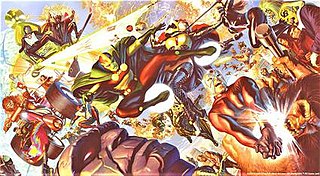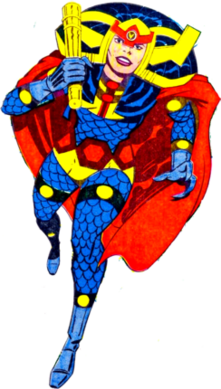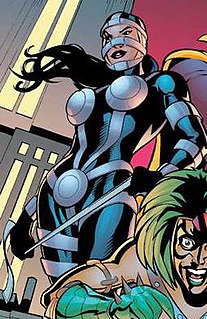Related Research Articles

"Fourth World" is a storyline told through a metaseries of connected comic book titles written and drawn by Jack Kirby and published by DC Comics from 1970 to 1973. Although they were not marketed under this title until the August–September 1971 issues of New Gods and Forever People, the terms Fourth World and Jack Kirby's Fourth World have gained usage in the years since.

Darkseid (Uxas) is a fictional supervillain appearing in comic books published by DC Comics. Created by writer-artist Jack Kirby, the character first made a cameo appearance in Superman's Pal Jimmy Olsen #134 in November 1970 before officially debuting in Forever People #1 in February 1971. He is usually depicted as the tyrannical ruler of the planet Apokolips whose ultimate goal is to conquer the universe by eliminating all hope and free will in sentient beings. A New God and one of the most powerful beings in the DC Universe, Darkseid serves as a staple Superman villain and the archenemy of the Justice League.

New Gods are a fictional race appearing in the eponymous comic book series published by DC Comics, as well as selected other DC titles. Created and designed by Jack Kirby, they first appeared in February 1971 in New Gods #1.

Mister Miracle is a fictional superhero appearing in American comic books published by DC Comics. He first appeared in Mister Miracle #1 and was created by Jack Kirby.

Orion is a fictional superhero that appears in comic books published by DC Comics.

DeSaad is a fictional supervillain, appearing in books published by DC Comics. He is one of the followers of Darkseid from the planet of Apokolips in Jack Kirby's Fourth World meta-series.

Apokolips is a fictional planet appearing in American comic books published by DC Comics. The planet is ruled by Darkseid, established in Jack Kirby's Fourth World comic book series, and is integral to many stories in the DC Universe. Apokolips is considered to be the opposite of the planet New Genesis.

New Genesis is a fictional planet appearing in American comic books published by DC Comics. The planet is in a parallel dimension adjacent to the main DC Universe. This planet, along with Apokolips, is speculated to be near the constellation Orion. It is the home-planet of the New Gods from Jack Kirby's Fourth World comic book series. Since the planet exists in a parallel dimension, it is only accessible by a method of travel called a boom tube.

Granny Goodness is a fictional supervillainess published by DC Comics.

Forever People are a fictional group of extraterrestrial superheroes appearing in American comic books published by DC Comics. They first appeared in Forever People #1, and were created by Jack Kirby as part of his "Fourth World" epic.

Big Barda is a fictional superheroine appearing in American comic books published by DC Comics. She first appeared in Mister Miracle #4, and was created by Jack Kirby. Jack Kirby based Barda's physical appearance on Lainie Kazan, who had recently appeared topless in Playboy. Mark Evanier, Kirby's assistant on the Fourth World comics, has stated, "Jack based some of his characters on people in his life or in the news... the characterization between Scott 'Mister Miracle' Free and Barda was based largely—though with tongue in cheek—on the interplay between Kirby and his wife Roz." In 2011, Big Barda was ranked 75th in Comics Buyer's Guide's "100 Sexiest Women in Comics" list.

Lightray (Solis) is a DC Comics superhero. Created by Jack Kirby for the "Jack Kirby's Fourth World" meta-series, he first appeared in New Gods #1. Lightray was a major character in New Gods volume 1 (1971-1978), as well as volume 2 (1984), volume 3 (1989-1991) and volume 4 (1995-1997). He has also appeared with Orion in the Cosmic Odyssey limited series (1988-1989), Jack Kirby's Fourth World (1997-1998) and Orion (2000-2002).

Infinity-Man is a fictional character appearing in DC Comics, in the Fourth World storyline.

Metron is a fictional character appearing in American comic books published by DC Comics.

Mantis is a fictional character that appears in comic books published by DC Comics, part of Jack Kirby's New Gods series.

Mother Boxes are fictional devices in Jack Kirby's Fourth World setting in the DC Universe.

Lashina is a fictional character, a supervillainess and Goddess warrior woman published by DC Comics.

Forager is a fictional superhero appearing in comic book published by DC Comics.
The Anti-Life Equation is a fictional mathematical equation appearing in American comic books published by DC Comics. In Jack Kirby's Fourth World setting, the Anti-Life Equation is a formula for total control over the minds of sentient beings, that is sought by Darkseid, who, for this reason, sends his forces to Earth, as he believes part of the equation exists in the subconsciousness of humanity. Various comics have defined the equation in different ways, but a common interpretation is that the equation is a mathematical proof of the futility of living.
References
- ↑ Young Justice #1, September 1998
| This DC Comics–related article is a stub. You can help Wikipedia by expanding it. |